Visiting Yosemite in June
Learn what to expect when visiting Yosemite National Park in June
Updated: 10/26/2022
June in Yosemite is typically warm and dry and marks the start of the busy summer season. There are many benefits to visiting in June as well as some drawbacks. Below, we have categorized the most common “when to go” questions to help you determine if June is the best time for you to visit.
benefits of visiting in june
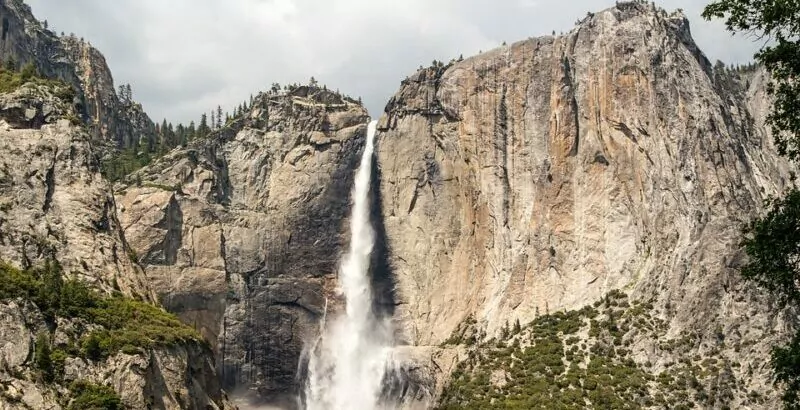 June in Yosemite is absolutely beautiful. The waterfalls are flowing, and the flowers are in peak bloom. As the snowpack begins to melt in the high elevations, the valley is flooded with moisture allowing flowers and other plants to bloom, drawing in more wildlife. The biggest benefit to visiting in June is that much of the snow has melted, so many trails are open. In summer, visitors have access to the entire park, from the summits to the valley floor. You have the entire park as your playground this time of year with almost no snow restrictions. Tioga Road and Glacier Point are open for cars to drive on. With these roads open, you are given access to Tuolumne Meadows and all the trails that lead from Tioga Road or Glacier Point, as well as access to the park’s north entrance over Tioga Pass from Lee Vining.
June in Yosemite is absolutely beautiful. The waterfalls are flowing, and the flowers are in peak bloom. As the snowpack begins to melt in the high elevations, the valley is flooded with moisture allowing flowers and other plants to bloom, drawing in more wildlife. The biggest benefit to visiting in June is that much of the snow has melted, so many trails are open. In summer, visitors have access to the entire park, from the summits to the valley floor. You have the entire park as your playground this time of year with almost no snow restrictions. Tioga Road and Glacier Point are open for cars to drive on. With these roads open, you are given access to Tuolumne Meadows and all the trails that lead from Tioga Road or Glacier Point, as well as access to the park’s north entrance over Tioga Pass from Lee Vining.
Another benefit of visiting in June is that it is the best time to experience hiking and backpacking in the park. Despite it being the start of the busiest time of the year, it is busy for a reason: Summer gives you the best access to trails that, even in spring, are covered in snow. There are few things like backpacking and hiking through– or above– this majestic valley and escaping the crowds by truly immersing yourself in the wilderness. In addition, iconic hikes and sights such as the hike up Half Dome and the overlook and hiking near Glacier Point are open and accessible. While not ideal for hiking, the weather, especially in early June, is less hot than the other summer months and can be more pleasant to explore in.
Besides the increased hiking options available, summer is the only time Yosemite’s water sports, such as rafting, swimming, and river floats, are available. The Merced River that runs the course of the valley is snow melt and bitingly cold, but after a long hike in the mountain sun, a dip in the water or float down the river is incredibly refreshing.
drawbacks of visiting in june
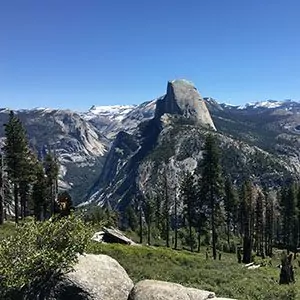 The biggest drawback to visiting in June is the crowds. Park visitation from just April to June doubles, and crowds only grow as the summer progresses. This means long lines for shuttle buses, difficulty obtaining permits, and peak season accommodation rates. Unfortunately, driving your own vehicle can be a pain, with traffic lines building up on narrow roads with no alternative routes. Unforeseen circumstances like a bear on the side of the road or a car accident can back up traffic for hours as there are no other options to get where you are going. Parking can also be a hassle as visitors circle like vultures around parking lots to try to snag a spot. Getting wilderness permits for backpacking or climbing Half Dome is a headache in the summer. Avoid this by booking with a guiding company that will handle all the logistics for you.
The biggest drawback to visiting in June is the crowds. Park visitation from just April to June doubles, and crowds only grow as the summer progresses. This means long lines for shuttle buses, difficulty obtaining permits, and peak season accommodation rates. Unfortunately, driving your own vehicle can be a pain, with traffic lines building up on narrow roads with no alternative routes. Unforeseen circumstances like a bear on the side of the road or a car accident can back up traffic for hours as there are no other options to get where you are going. Parking can also be a hassle as visitors circle like vultures around parking lots to try to snag a spot. Getting wilderness permits for backpacking or climbing Half Dome is a headache in the summer. Avoid this by booking with a guiding company that will handle all the logistics for you.
Another downside of Yosemite in June is the heat. Gone are the days of spring when the highs were in the mid-70s. The hot Sierra sun can be searing in the midday with highs in the 80s that feel much hotter than those used to humidity because of the intense dryness. But summer is the busiest season for a reason: there aren’t many downsides to Yosemite in June, except that everyone else knows there aren’t many downsides to visiting Yosemite in June.
If you have a low tolerance for crowds, but the only time you can visit the park is in the summer, there are ways to enjoy the park. Listed below are the best ways to escape the crowds in the summer:
- Get an early start: the earlier you rise, the more of the park you have to yourself before the crowds arrive.
- Go on a hike: the further you go on a trail, the more the crowds thin out.
- Plan ahead: the earlier you make reservations, the more likely you are to get the permits that you want.
- Go on a picnic: try to avoid the crowded eateries at lunchtime; instead, gather supplies from the general store and enjoy a picnic at one of the many overlooks in the park.
things to do in JUNE
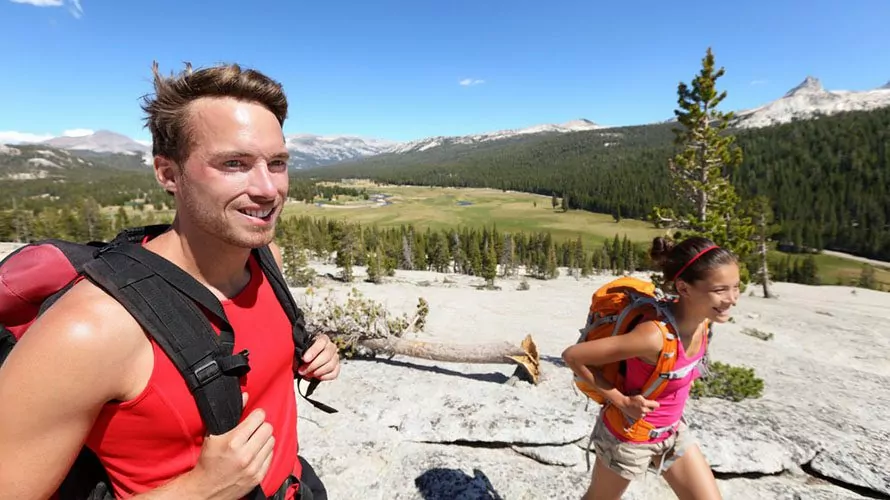 There is a ton to do in Yosemite in June. Most trails have opened, so you are able to climb to higher elevations for a fantastic vantage point of the Valley and high country. Day hiking is a great option if you want to experience Yosemite’s backcountry in a day. Hiking at Glacier Point or Tuolomne Meadows are both great options, and you can avoid the crowds if you take some of the lesser-known trails like Sentinel Dome or Taft Point. Backpacking is an extraordinary option if you have multiple days in the park and want to sleep in the backcountry among the peaks, pines, and stars. Many trails branch off from the famous John Muir Trail, which beings in Happy Isles and leads up out of the Valley– and away from the crowds. This can be turned into a longer hike or just an extended weekend getaway to Tuolumne Meadows. Alternatively, there is also backpacking along the rims of the valley, which is a beautiful respite from the crowds.
There is a ton to do in Yosemite in June. Most trails have opened, so you are able to climb to higher elevations for a fantastic vantage point of the Valley and high country. Day hiking is a great option if you want to experience Yosemite’s backcountry in a day. Hiking at Glacier Point or Tuolomne Meadows are both great options, and you can avoid the crowds if you take some of the lesser-known trails like Sentinel Dome or Taft Point. Backpacking is an extraordinary option if you have multiple days in the park and want to sleep in the backcountry among the peaks, pines, and stars. Many trails branch off from the famous John Muir Trail, which beings in Happy Isles and leads up out of the Valley– and away from the crowds. This can be turned into a longer hike or just an extended weekend getaway to Tuolumne Meadows. Alternatively, there is also backpacking along the rims of the valley, which is a beautiful respite from the crowds.
Biking in the Valley is also a great option, with 12 miles of paved and flat bike trail. Bus tours offer many different routes around the park, including tours of the Valley, Glacier Point Road, and a comprehensive tour that does the Valley, Glacier Point, and Mariposa Grove. Rafting on the Merced or horseback riding are options to get away from everyday activities, fishing, and wildlife viewing, as the resident animals around Yosemite are active in June. Deer, bears, coyotes, and many rodents are all common sights in Yosemite in June, even around the populated sections of the valley.
Photography is another great activity for summer as it is difficult to take a bad picture amid the stunning landscape. Try going on a photo scavenger hunt and get as many pictures as possible of one type of thing, be it rocks, clouds, wildlife, or other visitors in the park. If you’re feeling ambitious, venture out into the warmer summer nights and try your hand at star photography. As the rest of the park sleeps, you’ll get an entirely different view of Yosemite Valley, very likely alone with the stars, the wind in the pines, and maybe a coyote scouring the campground.
The Ansel Adams Gallery offers photography workshops and free camera walks if you’re into history and want a break from the heat or the bugs. The Yosemite Museum is another great option and features seasonal historical exhibits about Yosemite and the surrounding region. The Visitor Center in Yosemite Valley locates both. There are truly endless possibilities when it comes to Yosemite this time of year. Take your pick and get out there to enjoy it.
things to see in June
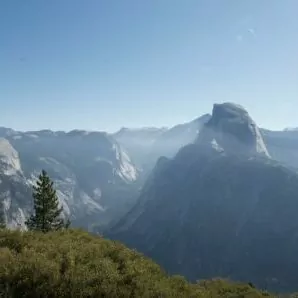 There are as many sights to see in June as there are things to do, so choosing between your options can be difficult. These two lists are based on whether you want to see the classic sights and photo locations which will be swarmed with crowds or if you want to take the road less traveled and see equally amazing sights with a better chance of having some peace and quiet. Neither list is exhaustive, so do your research to see what piques your interest.
There are as many sights to see in June as there are things to do, so choosing between your options can be difficult. These two lists are based on whether you want to see the classic sights and photo locations which will be swarmed with crowds or if you want to take the road less traveled and see equally amazing sights with a better chance of having some peace and quiet. Neither list is exhaustive, so do your research to see what piques your interest.
The Classic– but crowded– sights
Tunnel View: Perhaps the most famous view of the valley has been the subject of millions of photos; you have to stop at the tunnel view no matter how many times you’ve been there. El Capitan stands imposing to your left, Bridalveil Falls lives up to its name with shimmering wonder to your right, the iconic granite monolith sliced like a loaf of bread Half Dome rises in the distance, and the entire valley is laid out before you like a map with the Merced River snaking through the pines.
Vernal and Nevada Falls: This hike that leads you passed both Vernal and Nevada Falls on the Mist trail is probably the most popular waterfall hike in the park. The trail is moderate up to the first overlook of Vernal Falls at the footbridge. From that point, the Mist Trail, constantly sprayed by the thundering water, is a strenuous section leading to the top of Vernal Falls and Nevada Falls. Any portion of this hike is well worth the climb.
Glacier Point: Southwest of– and thousands of feet higher– than the tunnel view, this viewpoint gives you a different taste of the wonders of Yosemite National Park. If you drive this road the same day or after you visit the Mist Trail, you’ll be even more amazed as the thunderingly large waterfalls you saw yesterday are silent and small from this high up. Half Dome is to your left; if you look carefully, you might see hikers scaling the cables on the rounded side.
Road less traveled options
Taft Point: Only a few miles down the road from Glacier Point, this overlook requires a short hike instead of being entirely driven up like Glacier Point, but the lack of crowds and breathtaking views are worth the short hike. Instead of looking towards Half Dome, Taft Point brings you to the brink of the cliff opposite El Capitan and allows you to see the Valley from the side. Besides the fewer crowds, Taft Point allows brave visitors to get the iconic pictures at the edge of a 3000 ft cliff that plummets to the valley floor. Many guests choose to peer over while lying on their bellies. Lesser known and more of a trek to get to than Glacier Point, Taft Point is a fantastic alternative or addition to Glacier Point.
Tuolumne Meadows: Outside the valley on Tioga Pass lies Tuolumne Meadows, a gorgeous highland filled with lakes, streams, and rock formations. This area is out of the way and a good drive from the valley, so while it still receives its fair share of visitors, there are fewer crowds here than in the valley. You can even climb Lambert Dome and enjoy the wonderful views from the top. Drive up for the day, spend some time, and camp at the campground and explore the area. It will also be cooler up at the high elevations, providing a double respite from the valley.
Cloud’s Rest: Be not fooled; this hike is anything but restful. About a 14.5-mile trek to the top of this point, Cloud’s Rest is around 1,000 feet higher than Half Dome and provides a nearly identical view as well as great views of Half Dome itself. And while Half Dome is swarmed with crowds and has cable climbing, Cloud’s Rest will be peaceful and doesn’t require permits. Just as strenuous as Half Dome but with some extra perks, this is a must for those up for a challenge.
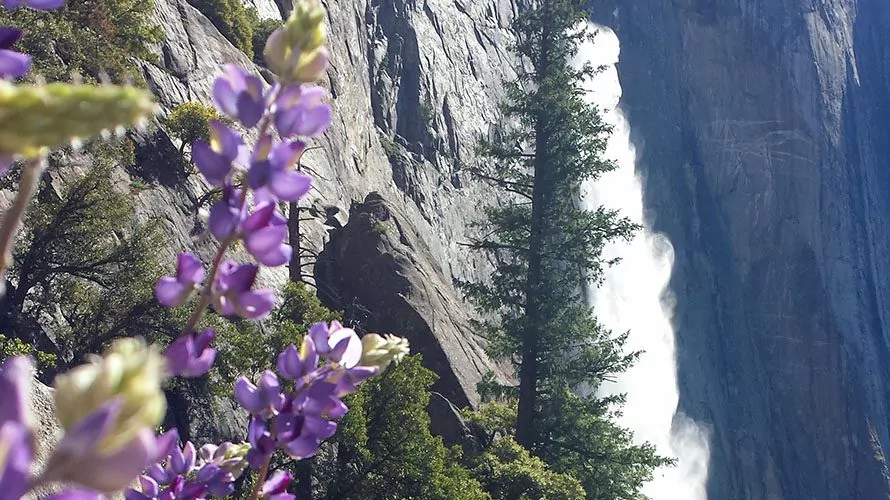
hiking in JUNE
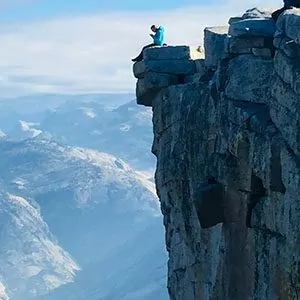 The hiking in Yosemite is world-class, and it is perfect in June as most of the trails have opened, and the weather is near-perfect. The park has over 800 miles of hiking trails which may lead to waterfalls, alpine lakes, or granite peaks. Trails vary in distance and difficulty, so there is something for all ages and levels of experience. You can read about the best hiking trails in Yosemite and NPS’ list of trails here.
The hiking in Yosemite is world-class, and it is perfect in June as most of the trails have opened, and the weather is near-perfect. The park has over 800 miles of hiking trails which may lead to waterfalls, alpine lakes, or granite peaks. Trails vary in distance and difficulty, so there is something for all ages and levels of experience. You can read about the best hiking trails in Yosemite and NPS’ list of trails here.
Perhaps the most famous option is the hike up Half Dome, the park’s unofficial icon. While this hike may be the most famous, it is by no means easy and should not be attempted by those who are out of shape or unprepared. The 14 to 16-mile round trip gains about 4,800 feet of elevation and ends with the infamous cables that allow guests to climb without rock climbing equipment. There have been few deaths on the cables in the last hundred years, but injuries are not uncommon for those acting foolishly. Most people take around 10 to 12 hours to hike Half Dome, and some take longer. It isn’t as well known that you cannot drive to the base of the monolith and hop on the cables but must trek a good distance to get there. While this hike is worth all the work it takes, make sure you are prepared and able to make the trek. It also requires permits that limit crowds which are allotted by a lottery system.
On the other end of the difficulty spectrum is Bridalveil Falls. This half-mile hike to one of the most stunning falls in the park is almost completely flat and great for all ages and abilities. In between these two options, the hike on the Mist Trail to Vernal and Nevada Falls is difficult. This hike starts out paved and then turns steep with large stone steps once you pass the first viewpoint of Vernal Falls. This section, the Mist Trail, is strenuous but short because of the constant misting from the waterfall. Once you get to the top of Vernal Falls, you can continue on if you wish to Nevada Falls. An alternative route on the John Muir Trail gives you a longer hike to Nevada Falls if you don’t want to do the slippery steps on Mist Trail. You can turn around at any point on this hike, making it great for those who are not sure how far they want to hike.
One last hiking spot to mention is on Glacier Point Road. Dewey Point and Sentinel Dome are great choices to escape some of the crowds and to see more of this gorgeous area than just the famous overlook. Remember that Glacier Point is around 3,000 ft higher in elevation than the valley, so you might feel some shortness of breath from the altitude.
Remember when hiking in Yosemite to bring plenty of water. It is getting into the warmer months, and with it being so dry, you will sweat a lot, but it will evaporate quickly, so it won’t feel like you are losing water. Bringing at least 3 liters of water for a day hike is recommended. Be sure to stick to the trail; going off-trail can lead to erosion as well as injury. And if hiking to a waterfall, never swim in a pool above the falls. Remember to be courteous to other hikers and practice good trail etiquette. There are a number of guided hikes available where you can take your pick of Yosemite’s wonders and be shown around by an expert in the area and in hiking.
backpacking in june
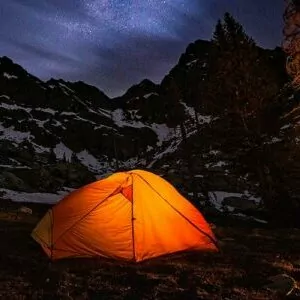
June is prime backpacking season as the trails are available, and the crowds have arrived so that backpackers can try to avoid them. Although you might still run into snow fields if you hike away from the valley, they will mostly likely be small and rather easy to traverse. Many backpackers chose to begin a thorough hike of the John Muir Trail at the northern end of the trail that begins in Yosemite Valley and rises up to Tuolumne and on south toward Kings Canyon and Sequoia. This hike can be done in various sections and add-ons of the trails nearby to create loops or in-and-back hikes depending on how long you want to be on the trail. A 4 or 5-day trip around the classic summits of Yosemite beginning in Tuolumne or a tour of Tuolumne’s Grand Canyon are great options for getting away from the crowds.
If you want a shorter trip staying closer to the famous areas in the valley, many backpacking options take you around the rims of Yosemite Valley instead of out and away from it altogether. A traverse along the great El Capitan or a trek along the north rim of the valley both offer spectacular views and can be done as shorter trips, even on an extended weekend.
Backpacking in June is almost perfect if you stay near the valley as the snow is almost gone, and the weather is warm but not yet the stifling dry heat of late summer. Do expect to see others on the trail, especially if you stay near Yosemite Valley, where you can backpack to places like Glacier Pointand and drive there. If you want to venture farther away from the valley and into higher elevations, you must acquire a permit many months in advance. If the snow year is heavy, you may run into larger snow fields which may be difficult to traverse and navigate. Even if you don’t encounter snow, backpackers planning to trek in June at any elevation should be prepared for high water levels as the snowpack continues to melt. This makes for higher- and more dangerous- stream crossings and possibly flooded and/or muddy trails. There are many logistics to figure out when planning a backpacking trip, and if you’ve never done one, you will benefit from booking a trip with a guiding company so that an expert guide can show you the ropes before you head out on your own.
weather in JUNE
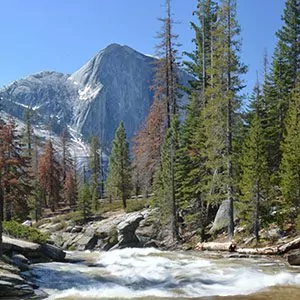
Yosemite National Park encompasses much more than just Yosemite Valley, with elevations ranging from 4,000 to 10,000 ft. As the locations with higher elevations open for the summer, the weather page that says “Yosemite” doesn’t quite give you enough information. However, overall weather in June is typically nice and warm with a lot of sun. The average temperature in Yosemite Valley in June is a high of 82 and a low of 50 degrees Fahrenheit (27/ 11 degrees Celsius). At 8,000 feet, the average temperature in Tuolumne Meadows is a high of 65 and a low of 33 degrees Fahrenheit (18/ 1 degrees Celsius). On average, it rains only one day in June.
Some say that June is the month the weather turns from agreeable as it was in May to being on the warmer side for the summer. While not nearly as hot as July and August, June can still be uncomfortably hot when hiking or backpacking in direct sunlight. The longer days in June also make it feel hotter since you are exposed to more sunlight throughout the day, and it doesn’t cool off until later in the evening. Of course, you can also take a dip in a river or lake to cool down, but you will find these to be icy cold as they are filled with melted snow. If visitors are planning to spend any time outside the park’s southern entrance near Oakhurst or Bass Lake, they will prepare for some major heat as those areas are typically much warmer than the valley. If visitors are from coastal areas or regions that are humid in the summer, such as the southern United States, make sure to bring lots of lotion because the dryness of the mountain air might crack your skin and make the heat seem even more intense.
If you are planning to take an excursion to Tuolumne Meadows or to do any activities at night like star photography or sitting around a campfire, it is best to bring some jackets and warmer layers still. While Yosemite will probably not be into its wildfire season until late June, the National Parks Service often runs controlled burns that mimic natural fires for the health of the forest. While these should not pose a health risk due to air quality, they can be annoying as the smoke and haze cloud your view of the sights.
Wildlife in june
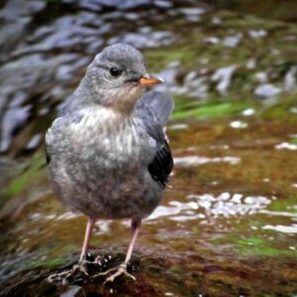 Yosemite is teeming with wildlife in June. It is difficult to drive through the park and not see some of the most iconic animals, such as mule deer grazing in the meadows and causally strolling by visitors. On nearly everyone’s list is seeing a black bear, and your chances are fairly good in populated areas as these bears often scavenge off of visitors’ food that was stored carelessly. Besides the famous animals, however, Yosemite is a hot spot for a great diversity of wildlife if visitors are patient enough to look for them. With so many sights to see and often so little time to see them, many visitors don’t make time to try and see– or notice– some of the park’s more particular and elusive species.
Yosemite is teeming with wildlife in June. It is difficult to drive through the park and not see some of the most iconic animals, such as mule deer grazing in the meadows and causally strolling by visitors. On nearly everyone’s list is seeing a black bear, and your chances are fairly good in populated areas as these bears often scavenge off of visitors’ food that was stored carelessly. Besides the famous animals, however, Yosemite is a hot spot for a great diversity of wildlife if visitors are patient enough to look for them. With so many sights to see and often so little time to see them, many visitors don’t make time to try and see– or notice– some of the park’s more particular and elusive species.
Snakes and other reptiles are out for the season by June, so watch out for the only venomous species, the Northern Pacific Rattle Snake, and make sure to give them a wide berth. If you journey down the Merced on a raft or alongside it on foot, keep your eyes peeled for the recently reintroduced river otters and occasional minks in the river. There is no end to the variety of birds, from the great gray owls to John Muir’s favorite and the only aquatic songbird in Yosemite, the American dipper that dives into streams to hunt for aquatic insects.
If guests have journeyed to Yosemite in June specifically to see wildlife, they would do well to venture into the backcountry and search for evidence of big horn sheep, fishers, bobcats, red foxes, or even mountain lions that all inhabit this part of the mountains but are shy and usually out at night or far away from visitors. If you’re interested, ask a park ranger at the visitor center what wildlife has been seen lately or has been caught on a motion sensor camera.
Recommended Wildland trips in june
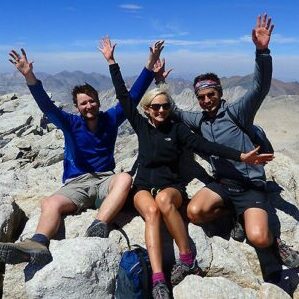 Wildland Trekking has a large selection of backpacking tours and camping trips in Yosemite that are great options for eliminating the headache of logistics and enjoying an all-inclusive adventure. Depending on your preferences, there are many options for those wanting a heavy mileage backpacking trip or a relaxing car camping or hotel experience. Feel free to explore all our Yosemite backpacking and camping trips in Yosemite, but here are a few we especially recommend in June.
Wildland Trekking has a large selection of backpacking tours and camping trips in Yosemite that are great options for eliminating the headache of logistics and enjoying an all-inclusive adventure. Depending on your preferences, there are many options for those wanting a heavy mileage backpacking trip or a relaxing car camping or hotel experience. Feel free to explore all our Yosemite backpacking and camping trips in Yosemite, but here are a few we especially recommend in June.
Half Dome Backpack: Remember that long, long hike to Half Dome that takes some visitors more than 12 hours to do in one day? As rewarding as the view from the top may be, most people will be exhausted by the end of the day and miss out on some of the enjoyment because the trek is so tiring. Your solution to this is to take a short backpacking trip instead and camp near the dome so that the hike will be shorter and you will be up on top before anyone else that is day hiking has time to reach it. This 4-day tour is great for those looking for an adventure without the stress of obtaining permits, planning an itinerary, or navigating the trails. Your expert guide will tell you everything there is to know and take you on an incredible journey you won’t forget.
Yosemite Autocamp Summer Hiking Tour: This 4-day camping tour will take you on hikes (both that are famous and popular and some lesser known) during the day and bring you to stay at Autocamp Yosemite at night, where guests will have private Airstream accommodations for a unique Yosemite experience. All-inclusive with accommodations, an expert guide, freshly prepared meals, local transportation, and a full itinerary of soaking up Yosemite’s wonders, you won’t want to this fantastic and relaxing Yosemite base camp tour.
Best of Yosemite Inn-Based Tour: Explore the wonders of Yosemite, knowing you have a soft bed to return to in the evening with this 5-day, inn-based tour. Each day is full of hiking both on popular routes and on lesser-known, less crowded hikes anywhere from the valley floor to the higher elevations of Tuolumne Meadows. Learn about the glacial and Native American history of the park from your expert guide during the day, and then return to cozy rooms and warm meals in the evening. Don’t worry about any of the food, lodging, transportation, or itineraries, as it is all included in this unforgettable Yosemite adventure.
JOIN A GUIDED HIKING ADVENTURE
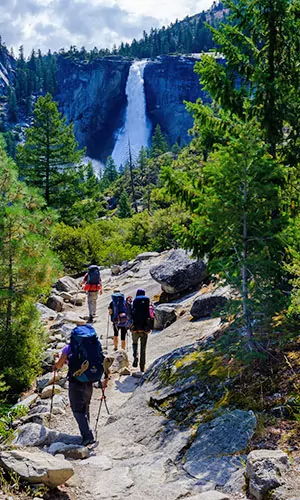 Yosemite National Park is home to some of the world’s most epic and fantastic hiking vacations. Wildland Trekking offers trips with the best of Yosemite: waterfalls, views, wildlife, solitude, adventure, and fascinating natural and cultural interpretation.
Yosemite National Park is home to some of the world’s most epic and fantastic hiking vacations. Wildland Trekking offers trips with the best of Yosemite: waterfalls, views, wildlife, solitude, adventure, and fascinating natural and cultural interpretation.
Guided Yosemite treks are all-inclusive, which covers permits; local transportation (excluded on specific tours); meals; equipment; safety systems, and professional hiking/wilderness guides; all of which allow visitors to maximize their time in Yosemite and focus entirely on enjoying the Park.
YOSEMITE ADVENTURE TOURS
GUIDED BACKPACKING ADVENTURES: these are for people interested in an authentic Yosemite hiking adventure away from the roads and crowds.
PORTERED TRIPS: on these innovative trips, guests hike with light day packs and camp near stunning backcountry locations.
INN-BASED PACKAGES: these tours are all-inclusive packages with lodging, amazing daily hikes, expert guides, meals, transportation, and more!
CAMPING-BASED HIKING PACKAGES: camping-based hiking packages provide all-around hiking experiences of Yosemite on wonderful outdoor vacations.
DAY HIKE TOURS: maximize your day in Yosemite on a fully guided, award-winning hiking tour on one of the Park’s best trails.





